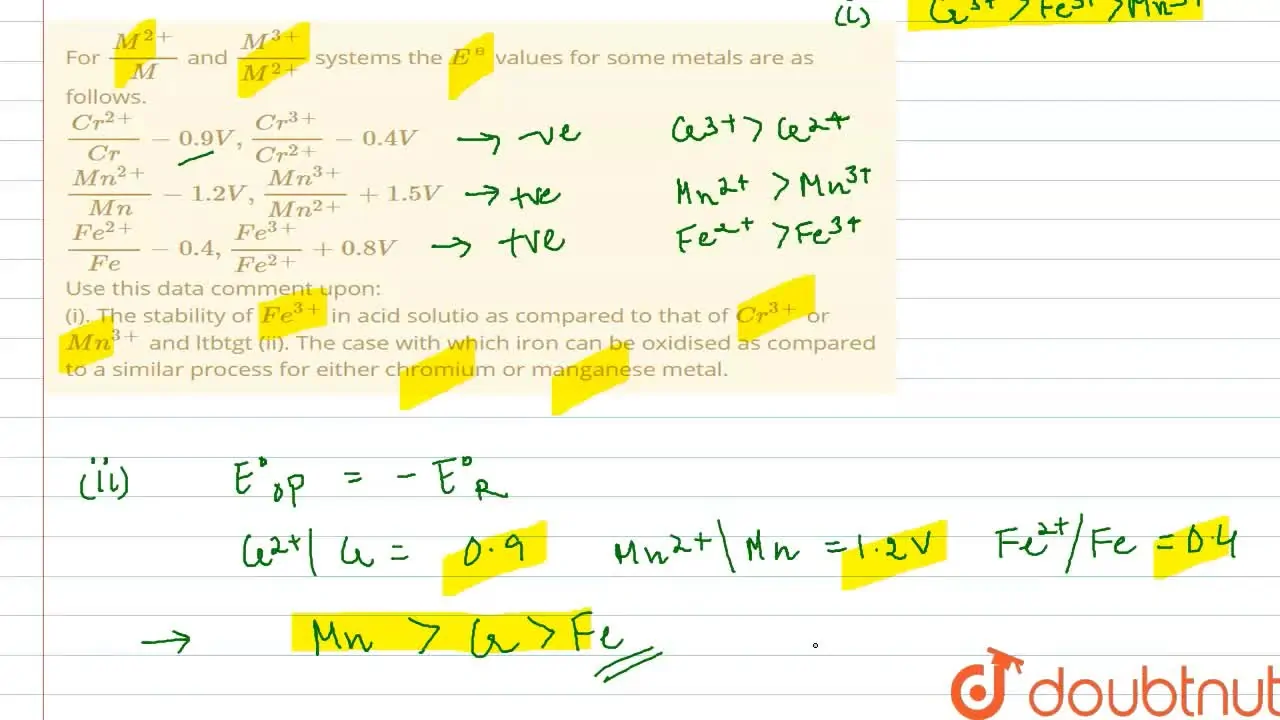For and systems the values for some metals are as follows.
Use this data comment upon:
(i). The stability of in acid solutio as compared to that of or and ltbtgt (ii). The case with which iron can be oxidised as compared to a similar process for either chromium or manganese metal.
(i) The value for is higher than that for and lower than that for . So, the reduction of to is easier than the reduction of to , but not as easy as the reduction of to . Hence, is more stable than , but less stable than . These metal ions can be arranged in the increasing order of their stability as:
(ii) The reduction potentials for the given pairs increase in the following order.
So, the oxidation of Fe to is not as easy as the oxidation of Cr to and the oxidation of Mn to . Thus, these metals can be arranged in the increasing order of their ability to get oxidised as:
Related Playlists
Similar Questions
The E∘ value in respect of the electrodes chromium (Z=24), manganese (Z=25) and iron (Z=26) are : Cr3+/Cr2+=−0.4V,Mn3+/Mn2+=+1.5V, " " Fe3+/Fe2=+0.8V.
On the basic of the above information compare the feasibilities
of further oxidation of their +2 oxidation states.View SolutionIf E∘Fe2+/Fe=−0.441V
and E∘Fe3+/Fe2+=0.771V
The standard EMF of the reaction
Fe+2Fe3+→3Fe2+
will be:View SolutionGiven Ec−.Fe2+∣Fe and Ec−.Fe3+∣Fe2+ are −0.44 and 0.77V respectively.
If Fe2+,Fe3+ and Fe blocks are kept together, thenView SolutionWhy is the value for Mn3+Mn2+ couple much more positive than that for Cr3+Cr2+ or Fe3+Fe2+? Explain
View SolutionWhat is the potential for the cell
Cr∣∣Cr3+(0.1M)∣∣∣∣Fe2+(0.01M)∣∣Fe
E∘Cr3+/Cr=−0.74V,
E∘Fe2+/Fe=−0.44VView SolutionGiven
E0cr3+/Cr=−0.74V,E0MnO4/Mn2+=1.51cm
E0Cr2O2−7/Cr3+=1.33V,E0Cl/Cl−=1.36V
Based on the data given above, strongest oxidising agent will be:View SolutionThe emf of the cell Cr(s)∣∣Cr3+(1.0M)∣∣∣∣Co2+(1.0M)∣∣Co(s)[Eo For Cr3+∣∣Cr(s)=−0.74V&Co2+∣∣Co(s)−0.28V]:
View SolutionGiven that E.Fe2+/Fe=−0.44V,E∘Fe3+/Fe2+=0.77V if Fe2+,Fe3+ and Fe solid are kept together then
View SolutionIf E∘Fe3+/Fe and E∘Fe2+/Fe are −0.36V and 0.439V respectively, then value of E∘Fe3+/Fe2+ is
View SolutionIf Ec−.Fe3+∣Fe and Ec−.Fe2+∣Fe are =−0.36V and −0.439V, respectively, then the value of Ec−.Fe3+∣Fe2+
View Solution


